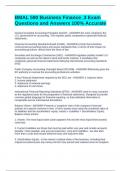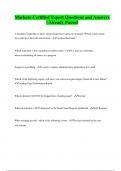Exam (elaborations)
BMAL 590 Business Finance_3 Exam Questions and Answers 100% Accurate
- Course
- Institution
BMAL 590 Business Finance_3 Exam Questions and Answers 100% AccurateBMAL 590 Business Finance_3 Exam Questions and Answers 100% AccurateBMAL 590 Business Finance_3 Exam Questions and Answers 100% AccurateGeneral Accepted Accounting Principles (GAAP) - ANSWER-the rules created by the U.S. government...
[Show more]




